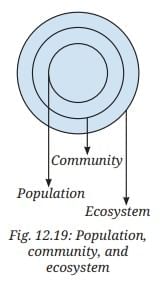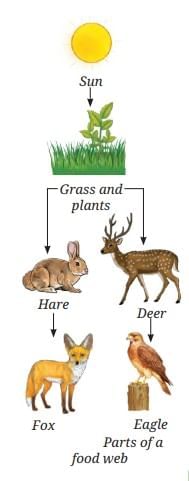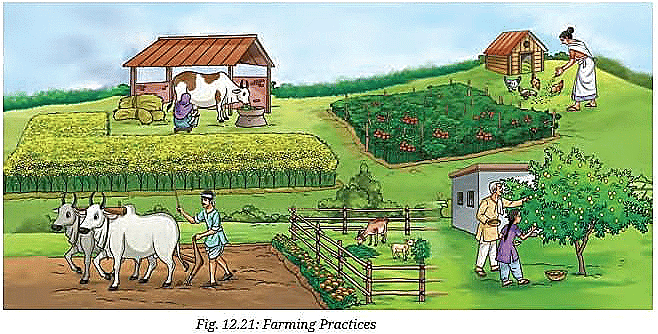How Nature Works in Harmony NCERT Solutions | Science Curiosity Class 8 - New NCERT PDF Download
Probe and Ponder (Page 190)
Q1: How might the loss of forest cover and changes in rainfall patterns lead to elephants entering human farms and villages?
Ans: Loss of forest cover reduces vegetation and habitat space, while changes in rainfall patterns can dry up waterholes, making food and water scarce in elephants’ natural habitats. As a result, elephants wander into nearby farms and villages in search of crops like bananas and sugarcane, leading to crop damage and potential harm to humans and animals.
Q2: Imagine you are a tree in a dense forest. What kind of relationships would you have with water, sunlight, other animals, and other components of the forest?
Ans: As a tree, I would:
- Water: Absorb water from the soil for photosynthesis and growth.
- Sunlight: Use sunlight to produce food via photosynthesis.
- Other Animals: Provide shelter, food (fruits, leaves), and oxygen for animals; animals like birds and insects aid in pollination and seed dispersal.
- Other Components: Interact with soil for nutrients and stability, contribute to air quality by releasing oxygen, and help retain soil moisture to prevent erosion.
Q3: Do you think the Earth can thrive without humans? Can humans survive without the Earth?
Ans: Earth without humans: Yes, Earth can thrive without humans. Ecosystems, such as forests and aquatic systems, function through natural interactions (e.g., food chains, nutrient cycling) without human intervention. Protected areas like national parks show ecosystems can self-sustain.
Humans without Earth: No, humans cannot survive without Earth, as they depend on ecosystems for air, water, food, and resources essential for survival.
Q4: If two kinds of birds compete for the same fruit, how might their way of living change over time?
Ans: Competition may lead to niche differentiation, where one bird species adapts to feed at different times or on different parts of the fruit tree to reduce competition. Over time, they may evolve distinct beak shapes or feeding behaviours, or one species may dominate, forcing the other to find alternative food sources or habitats.
Q5: Can human actions cause natural disasters?
Ans: Human actions can exacerbate or trigger events that resemble natural disasters. For example, deforestation and pollution can worsen floods or storms by destabilising soil and altering weather patterns. Overuse of pesticides can disrupt ecosystems, indirectly contributing to environmental imbalances.
Q6: Share your questions
Ans: Here are some fun questions from the chapter:
- How do decomposers help recycle waste?
- Why are mangroves important for coastal areas?
- What happens if predators disappear from a forest?
- How can we make farming more eco-friendly?
Keep the Curiosity Alive (Page 207 - 208)
Q1: Refer to the given diagram (Fig. 12.19) and select the wrong statement.
(i) A community is larger than a population.
(ii) A community is smaller than an ecosystem.
(iii) An ecosystem is part of a community. Ans: (iii) An ecosystem is part of a community.
Ans: (iii) An ecosystem is part of a community.
Actually, a community (groups of populations) is part of an ecosystem, which includes both living things and non-living parts like soil and water. The other statements are correct: communities are larger than populations and smaller than ecosystems.
Q2: A population is part of a community. If all decomposers suddenly disappear from a forest ecosystem, what changes do you think would occur? Explain why decomposers are essential.
Ans: Changes: Dead plants and animals would accumulate, nutrients would not return to the soil, and plant growth would decline. This could lead to a reduction in herbivore and carnivore populations due to food scarcity.
Why Essential: Decomposers (e.g., fungi, bacteria) break down dead matter into simpler substances, recycling nutrients like nitrogen and carbon back into the soil for plants. Without them, the nutrient cycle would stop, disrupting the food web.
Q3: Selvam from Cuddalore district, Tamil Nadu, shared that his village was less affected by the 2004 Tsunami compared to nearby villages due to the presence of mangrove forests. This surprised Sarita, Shabnam, and Shijo. They wondered if mangroves were protecting the village. Can you help them understand this?
Ans: Yes, mangroves protected the village. Mangrove forests act as natural barriers, slowing down strong winds and waves during storms and tsunamis. Their roots stabilize soil, reducing erosion, and they absorb water impact, protecting coastal areas. The Sundarbans’ mangroves, a World Heritage Site, demonstrate this protective role.
Q4: Look at this food chain: Grass → Grasshopper → Frog → Snake. If frogs disappear from this ecosystem, what will happen to the population of grasshoppers and snakes? Why?
Ans: If frogs disappear from this ecosystem, the grasshopper population will increase because frogs are their natural predators, and without frogs, there will be nothing to control the grasshoppers’ numbers. On the other hand, the snake population will decrease because frogs are a major part of their diet, and without frogs, snakes will have less food available, which may lead to a decline in their numbers. This illustrates how the removal of a species in the middle of a food chain can cause a trophic cascade, affecting both the species it preys on and the species that prey on it.
Q5: In a school garden, students noticed fewer butterflies the previous season. What could be the possible reasons? What steps can students take to have more butterflies on campus?
Ans:
- Possible reasons: Possible causes include pesticide use killing larvae, loss of nectar plants, or increased predators (e.g., birds). Monoculture or pollution might also reduce habitat quality.
- The steps we can take: Plant diverse nectar-rich flowers (e.g., marigolds), avoid pesticides, create sheltered areas, and install butterfly feeders or water sources to attract and support butterflies.
Q6: Why is it not possible to have an ecosystem with only producers and no consumers or decomposers?
Ans: An ecosystem needs consumers to regulate producer populations (e.g., herbivores eat plants) and decomposers to recycle dead matter into nutrients for producers. Without consumers, producers would overgrow and die from competition; without decomposers, nutrients would not cycle, collapsing the system.
Q7: Observe two different places near your home or school (e.g., a park and a roadside). List the living and non-living components you see. How are the two ecosystems different?
Ans: We can see some common things near our home and school, such as
- Park: Living (trees, birds, squirrels, grass); Non-living (soil, water, benches, sunlight).
- Roadside: Living (weeds, insects); Non-living (asphalt, dust, car exhaust).
Differences: The park is a designed ecosystem with diverse plants and animals, supported by soil and water, while the roadside is a disturbed, human-altered area with fewer species and more pollution.
Q8: ‘Human-made ecosystems like agricultural fields are necessary, but they must be made sustainable.’ Comment on the statement.
Ans: Agree. Agricultural fields provide food but often use unsustainable practices (e.g., synthetic fertilisers, monoculture) that degrade soil and harm biodiversity. Sustainable methods (e.g., organic farming, crop rotation) ensure long-term productivity and environmental health.
Q9: If the Indian hare population (Fig. 12.20) drops because of a disease, how would it affect the number of other organisms? Ans:
Ans:
- Predators: The numbers of foxes and eagles would decrease due to reduced prey (hares), leading to food scarcity.
- Plants: Grass and plant populations might increase initially without hare grazing, but overgrowth could alter the habitat.
- Deer: Since deer aren’t preyed on by foxes or eagles, their role in this particular chain isn’t disturbed directly.
- Why: A decline in a key herbivore like the hare disrupts the food web, affecting both higher (predators) and lower (plants) trophic levels.
Discover, Design, and Debate (Page 208 - 209)
Q1: Plan a clean-up day at school or a nearby park. Wearing gloves and using bags, collect the litter you find. Discuss the kinds of waste you found. Which was the most common? How can we reduce such waste?
Ans: Organize with friends—pick a Saturday, get gloves, bags, and posters saying "Keep Nature Clean!"
Common waste: Plastic bottles, wrappers, paper. Plastics are most common because they're not biodegradable.
Reduce by using reusable bags, recycling, and teaching others—no littering! This helps ecosystems by preventing pollution that harms animals and plants.
Q2: In Arunachal Pradesh, the Nyishi and Mishmi tribes treat the Tiger as sacred. In Chhattisgarh, the Baiga tribe worships Bagheshwar or Bagesur Dev and believes the Tiger is the protector of the forest. Find out about another Indian tribe that has a special bond with any animal.
Ans: The Bishnoi tribe in Rajasthan has a special bond with blackbucks (antelopes). They protect them as sacred, following Guru Jambheshwar's teachings to not harm animals or trees. This helps conserve wildlife—Bishnois even risk their lives to save them! It's a great example of how culture protects ecosystems.
Q3: Pick a tree near your home or school. Observe it once a week for 4 weeks. Note any new leaves, flowers, fruits, or visiting birds and insects. Record your observations. You may even upload your findings to www.seasonwatch.in and become a young citizen scientist.
Ans: I picked a mango tree.
Week 1: New green leaves budding, ants crawling.
Week 2: Small flowers blooming, bees visiting.
Week 3: Tiny fruits forming, birds like sparrows perching.
Week 4: Fruits growing bigger, squirrels eating. Upload to SeasonWatch to track changes with seasons—it's fun and helps scientists study climate effects on trees!
Q4: Interact with farmers and record indigenous practices followed by them for sustainable farming. Create a sustainable herbal garden/natural farm at home or at school. It could be a group activity with students from different grades.
Ans: Talked to a farmer who uses cow dung as natural fertilizer (compost) and plants marigolds to repel pests - instead of chemicals.
For our school garden: Plant herbs like tulsi and mint in pots with organic soil, water wisely, and rotate crops. Involve juniors to weed and seniors to label - it's sustainable, provides fresh herbs, and teaches eco-farming!
Q5: Look at Fig. 12.21 to understand the different farming practices adopted by farmers or you may also visit a nearby farm with an elderly person to observe the same. List a few suggestions in your notebook to improve farming practices by adopting eco-friendly and sustainable techniques. You can also make posters or model and display while participating in school functions, science fairs or Krishi Mela. The school may also invite agricultural scientists, farmers, and experts to discuss the prevalent farming practices with the students. Ans: From the figure/visit: Farmers use crop rotation, natural manure, and drip irrigation.
Ans: From the figure/visit: Farmers use crop rotation, natural manure, and drip irrigation.
Suggestions: Use compost instead of chemicals, plant diverse crops to boost soil health, harvest rainwater. Make posters like "Go Organic for Healthy Soil!" and a model farm with recycled materials. Invite experts for a talk—learn about Vrikshayurveda (ancient organic methods) and share in a school fair!
|
59 videos|236 docs|13 tests
|
FAQs on How Nature Works in Harmony NCERT Solutions - Science Curiosity Class 8 - New NCERT
| 1. What are some effective ways to keep curiosity alive in learning about nature? |  |
| 2. How can planning a clean-up day benefit the environment and the community? |  |
| 3. What role do farmers play in maintaining ecological balance? |  |
| 4. Why is observing trees important for understanding ecological systems? |  |
| 5. How can interaction with farmers enhance knowledge about farming practices? |  |





















